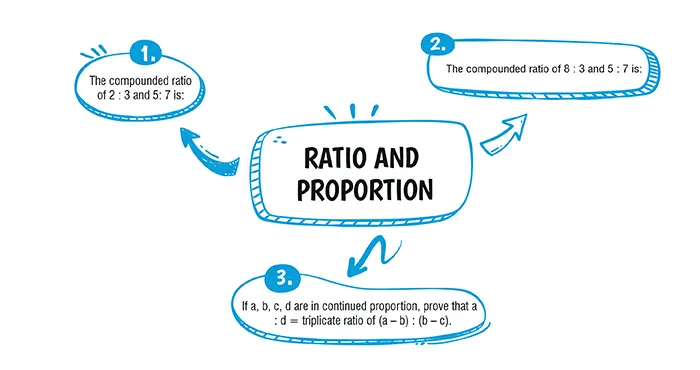Table of Contents

Ans. (d) 10 : 21
Explanation:
Compounded ratio of 2 : 3 and 5 : 7
= \frac{2}{3} × \frac{5}{7} = \frac{10}{21}
Ans. (b) 40 : 21
Explanation:
Compounded ratio of 2 : 3 and 5 : 7
= \frac{8}{3}× \frac{5}{7} = \frac{40}{21}
Explanation:
Given, a, b, c, d are in continued proportion.
∴ \frac{a}{b} = \frac{b}{c} = \frac{c}{d} = k (say) \\
⇒ c = kd, b = kc =k^2d, a = kb = k^3d \\
Now, \\
L.H.S. = a : d = \frac{a}{b} = \frac{k^3d}{d} = k^3 \\
\text{R.H.S. = Triplicate ratio of (a – b) : (b – c)} \\
= \frac{(a - b)^3}{(b - c)^3}
= \left(\frac{k^3d - k^2d}{k^3d - kd}\right)^2 = \left(\frac{k^2d(k-1)}{kd(k-d)}\right) = k^3 \\
Thus, L.H.S. = R.H.S. Hence Proved.
Explanation:
Since, b is the mean proportion between a and c.
So, b4 = ac .L.H.S.
= \dfrac{a^2 - b^2 + c^2}{a^{-2} - b^{-2} + c^{-2}} \\
= \dfrac{a^2 - b^2 + c^2}{\dfrac{1}{a^2} - \dfrac{1}{b^2} + \dfrac{1}{c^2}} \\
= \dfrac{(a^2 - b^2 + c^2)}{\dfrac{b^2c^2 - a^2c^2 + a^2b^2}{a^2b^2c^2}} \\
= \dfrac{a^2b^2c^2(a^2 - b^2 + c^2)}{b^2c^{-2} - b^4 + a^2b^2} \\
= \dfrac{b^4×b^2(a^2 - b^2 + c^2)}{b^2(c^2 - b^2 + a^2)}\\
= b4 = R.H.S.
Explanation:
Let the required line be AB cut off positive intercepts OA and OB on X-axis and Y-axis respectively.
∵ OA : OB = 2 : 3,
let OA = 2a and OB = 3a.
∴ A = (2a, 0) and B = (0, 3a)
Equation of a line is given as
y - y^2 = \dfrac{y_2 - y_1}{x_2 - x_1}(x - x_1) \\
⇒ y - 0 = \dfrac{3a - 0}{0 - 2a}(x - 2a) \\
⇒ y = - \dfrac{3a}{2a}(x - 2a) \\
⇒ 2y = – 3(x – 2a) \\
⇒ 2y = – 3x + 6a \\
⇒ 3x + 2y – 6a = 0 ...(i) \\
∵ It passes through P(1, 2), Putting x = 1, y = 2,
we get
3 × 1 + 2 × 2 – 6a = 0
⇒ 7 – 6a = 0
⇒ 6a = 7
⇒ a = \dfrac{7}{6} \\
\text{∴ From equation (i),} \\ 3x + 2y - 6 × \dfrac{7}{6} = 0 \\
⇒ 3x + 2y – 7 = 0, \\
\text{which is the required equation of line}\\
⇒ slope of AB = -\dfrac{\displaystyle{Coefficient\space of\space x}}
{\displaystyle{Coefficient\space of\space y}}= - \dfrac{3}{2}.
Download Mind Map of this chapter
Download NowWant to Practice Mock Tests of this chapter
Practice NowDownload Important Questions of this chapter
Download Now| Chapter No. | Chapter Name |
|---|---|
| Chapter 1 | Goods and Service Tax (GST) |
| Chapter 2 | Banking |
| Chapter 3 | Shares and Dividends |
| Chapter 4 | Linear inequations |
| Chapter 5 | Quadratic Equations in one variable |
| Chapter 6 | Ratio and proportion |
| Chapter 7 | Factorization |
| Chapter 8 | Matrices |
| Chapter 9 | Arithmetic Progression |
| Chapter 10 | Geometric Progression |
| Chapter 11 | Coordinate Geometry |
| Chapter 12 | Reflection |
| Chapter 13 | Similarity |
| Chapter 14 | Loci |
| Chapter 15 | Circles |
| Chapter 16 | Constructions |
| Chapter 17 | Mensuration |
| Chapter 18 | Trigonometry |
| Chapter 19 | Statistics |
| Chapter 20 | Probability |
| Chapter Wise Important Questions for ICSE Board Class 10 Mathematics |
|---|
| Goods and Service Tax (GST) |
| Banking |
| Shares and Dividends |
| Linear inequations |
| Quadratic Equations in one variable |
| Ratio and proportion |
| Factorization |
| Matrices |
| Arithmetic Progression |
| Geometric Progression |
| Coordinate Geometry |
| Reflection |
| Similarity |
| Loci |
| Circles |
| Constructions |
| Mensuration |
| Trigonometry |
| Statistics |
| Probability |
CBSE Important Questions Class 10
ICSE Important Questions Class 10
CBSE Important Questions Class 10
ICSE Important Questions Class 10